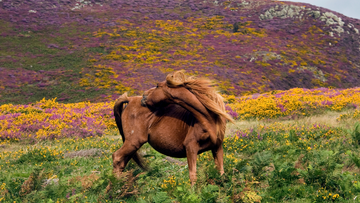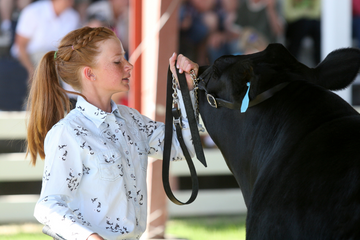Suspensory ligament horse injuries—often referred to as a suspensory sprain or suspensory desmitis—are caused by an overextension of the suspensory ligament and can be debilitating, as they’re a crucial part of how your horse moves. If your horse is in regular training or competition, you’ll want to learn the signs of a suspensory ligament injury so that you can intervene with healing protocol as soon as possible.
What Are Suspensory Ligaments?

A ligament attaches two or more bones to the horse’s body. The suspensory ligament in horses is an important connective ligament between the cannon bone and the sesamoid bones at either side of the back of the horse’s fetlock and the pastern. The suspensory ligament is fibrous and strong but not very elastic. Therefore, it is prone to be injured not only by a one-time overextension but also by the buildup of mild overextension over time.
What is Suspensory Desmitis?
Suspensory desmitis in horses is essentially the spraining—or overextension to the point of injury—of the equine suspensory ligament. The sprain can include inflammation of the ligament and micro tears, and even more pronounced tears where the ligament meets the bones. However, complete rupture is uncommon and often seen in older broodmares (due to deterioration, not athletic injury).
Recognizing a Suspensory Injury
Certain disciplines can put your horse at a higher risk of suspensory injury. Dressage, show jumping, eventing, racing, reining, and cutting all require precise movements and, in some cases, high speeds or impact. This stress on the joints, muscles, and ligaments increases the risk of injury.
Suspensory ligament injuries often build as slowly increasing lameness, and they’re often bilateral (meaning that both front or hind legs will sustain injuries around the same time). Suspensory injuries can also be acute (sudden, often caused by trauma) or chronic (degeneration over a long period of time)
While you might notice heat, swelling, and sensitivity when palpating the ligament, not all suspensory injuries have swelling. Some present with increasing lameness and thickening of the ligament. Symptoms can range from mild to severe, depending on the extent of the injury, and the sprain can be located on the top, middle, or bottom of the ligament, spanning much of your horse’s lower leg. In the rare case of a complete suspensory ligament rupture, you’ll notice the fetlock completely sink.
Diagnosing & Treating Suspensory Injuries
As with most injuries, the earlier you identify it, the better the recovery will be for your horse. If you suspect an injury, contact your veterinarian. Using a combination of flexion tests and ultrasound, they can identify pain, inflammation, tears, or ligament deterioration. Rest, anti-inflammatories, and supportive care are the most important for recovery. Most vets recommend stall rest or minimal turnout to reduce strain and inflammation.
Shockwave and cold therapy can also be beneficial and are proven to reduce inflammation and pain. Other supportive therapies like the Benefab® Therapeutic Smart QuickWraps and the Benefab® Therapeutic SmartScrim can improve circulation and reduce inflammation. In severe cases, surgical intervention may be needed.






















